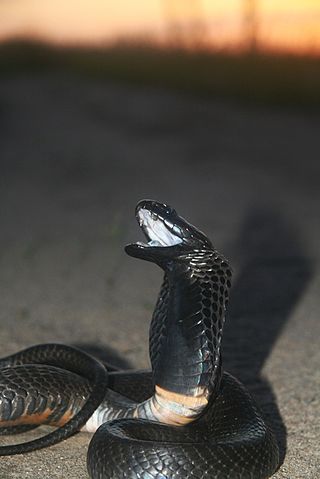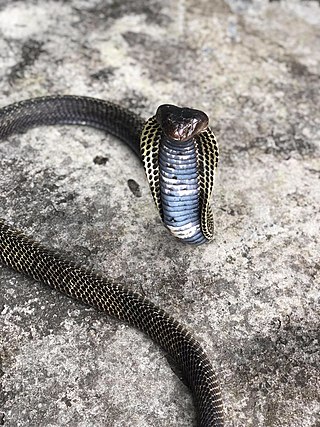
A spitting cobra is any of several species of cobras that can defensively spray a toxic secretion - functioning as both a venom and a toxungen - from their fangs into the eyes of an attacker.

The monocled cobra, also called monocellate cobra and Indian spitting cobra, is a venomous cobra species widespread across South and Southeast Asia and listed as Least Concern on the IUCN Red List.

The Cape cobra, also called the yellow cobra, is a moderate-sized, highly venomous species of cobra inhabiting a wide variety of biomes across southern Africa including arid savanna, fynbos, bushveld, desert and semi-desert regions.

Naja is a genus of venomous elapid snakes commonly known as cobras. Members of the genus Naja are the most widespread and the most widely recognized as "true" cobras. Various species occur in regions throughout Africa, Southwest Asia, South Asia, and Southeast Asia. Several other elapid species are also called "cobras", such as the king cobra and the rinkhals, but neither are true cobras, in that they do not belong to the genus Naja, but instead each belong to monotypic genera Hemachatus and Ophiophagus.

The many-banded snake, also known as the burrowing cobra is a species of venomous elapid snake. The species is found in the Republic of Congo, the Democratic Republic of Congo and Cameroon in Africa.

The Mozambique spitting cobra is a highly venomous species of spitting cobra native to Africa. It is largely found in Angola, Botswana, Malawi, Mozambique, Namibia, South Africa, Tanzania, Zambia, and Zimbabwe.

The rinkhals, also known as the ringhals or ring-necked spitting cobra, is a species of venomous snake in the family Elapidae. The species is found in parts of southern Africa. It is not a true cobra in that it does not belong to the genus Naja, but instead belongs to the monotypic genus Hemachatus. While rinkhals bear a great resemblance to true cobras they also possess some remarkable differences from these, resulting in their placement outside the genus Naja.

The red spitting cobra is a species of spitting cobra native to Africa.

The Egyptian cobra, also known as Ouraeus(derived from the Ancient Greek word: οὐραῖος - Greek pronunciation: [οὐραῖος]), is one of the most venomous snakes in North Africa, which has caused many snakebite incidents to humans. It averages roughly 1.4 metres (4.6 ft), with the longest recorded specimen measuring 2.59 metres (8.5 ft).
Naja ashei, commonly known as Ashe's spitting cobra or the giant spitting cobra, is a species of venomous snake in the family Elapidae. The species is native to Africa. It is the world's largest species of spitting cobra.

The Indochinese spitting cobra also called the Thai spitting cobra, black and white spitting cobra, Siamese spitting cobra, is a species of spitting cobra found in Southeast Asia.

Naja annulata, commonly known as the banded water cobra or the ringed water cobra, is a species of water cobra native to western and central Africa.

The black-necked spitting cobra is a species of spitting cobra found mostly in sub-Saharan Africa. They are moderately sized snakes that can grow to a length of 1.2 to 2.2 m in length. Their coloration and markings can vary considerably. They prey primarily on small rodents. They possess medically significant venom, although the mortality rate for untreated bites on humans is relatively low. Like other spitting cobras, they can eject venom from their fangs when threatened. The neurotoxic venom irritates the skin, causing blisters and inflammation, and can cause permanent blindness if the venom makes contact with the eyes and is not washed off.

The forest cobra, also commonly called the black cobra and the black and white-lipped cobra, is a species of venomous snake in the family Elapidae. The species is native to Africa, mostly the central and western parts of the continent. It is the largest true cobra species with a record length of 3.2 metres.

The Equatorial spitting cobra also called the black spitting cobra, Malayan spitting cobra, golden spitting cobra, Sumatran spitting cobra, or Palawan spitting cobra, is a species of spitting cobra found in Southeast Asia.
The Senegalese cobra is a species of cobra in the genus Naja that is found in West Africa.

Naja christyi, commonly known as the Congo water cobra or Christy's water cobra, is a species of venomous snakes belonging to the family Elapidae. The species is native to Sub-Saharan Africa.

Anchieta's cobra, sometimes referred to as the Angolan cobra, is a species of venomous snake in the family Elapidae. The species is native to Southern Africa.

The Mandalay spitting cobra, also called the Burmese spitting cobra or Mandalay cobra, is a species of spitting cobra endemic to the dry zone in central Myanmar.

The Andaman cobra or Andaman spitting cobra is a species of cobra endemic to the Andaman Islands of India. The name of this cobra comes from the Islands itself. The species has a very potent venom, and is capable of “spitting”, although this defensive behavior is very rare and the aim is poor and not as efficient as “true spitting cobras”.





















